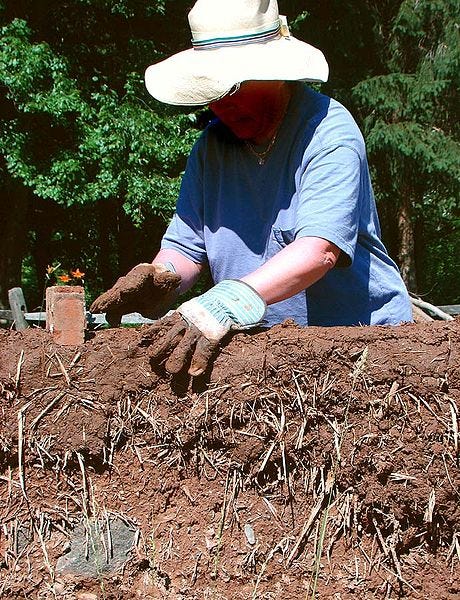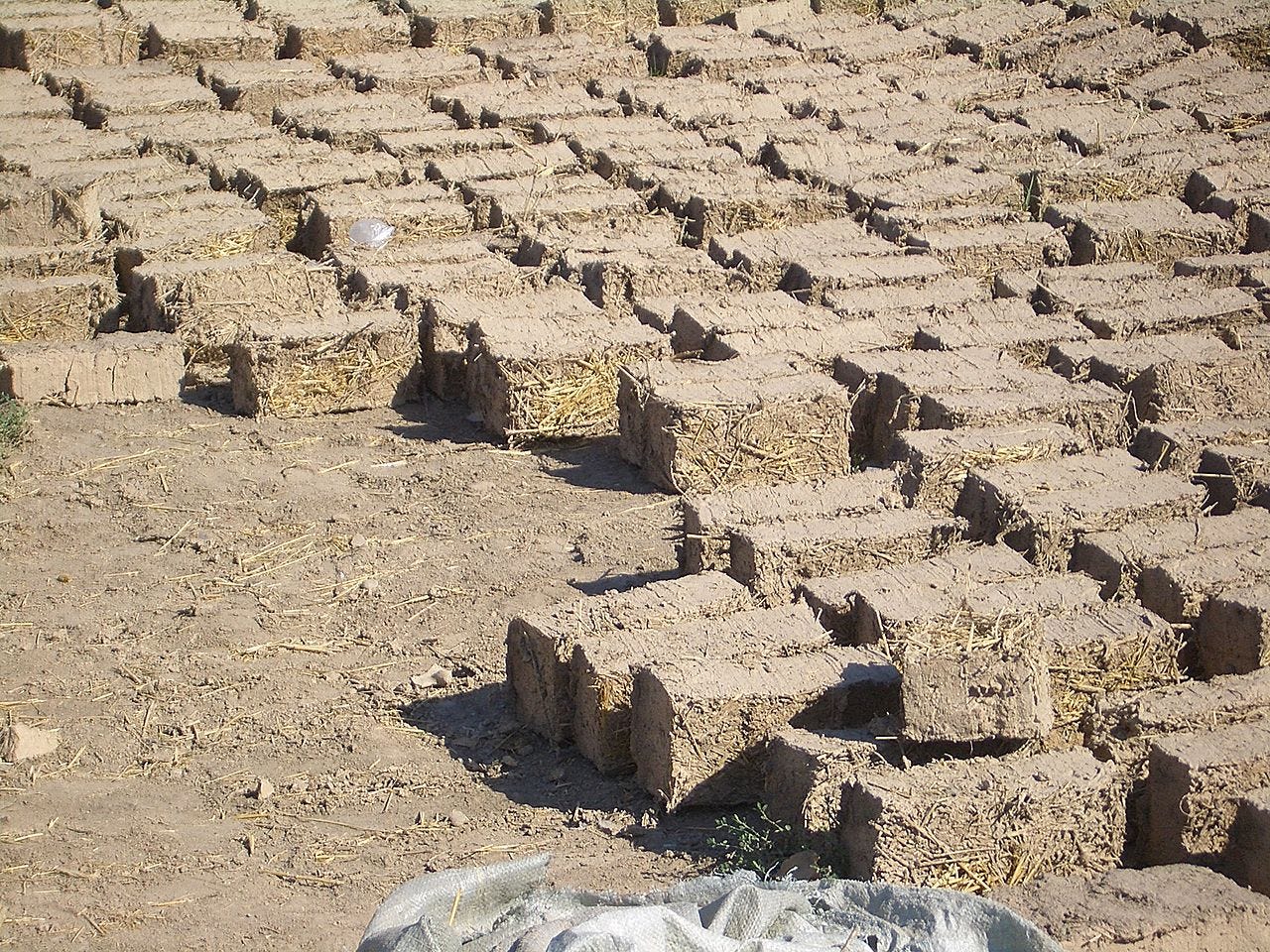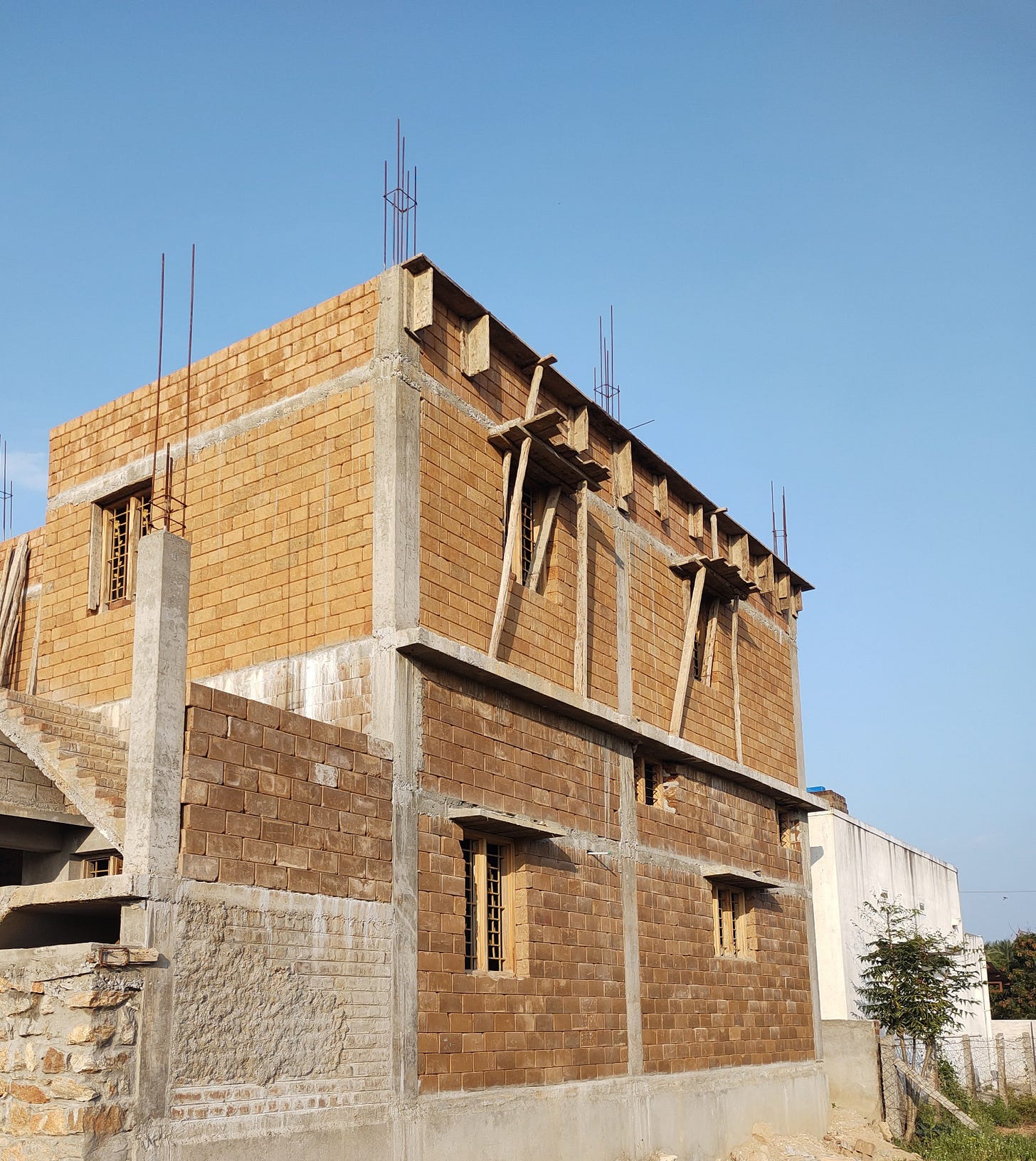With all the thoughts of my boyhood mud house, I was all set for building my next mud house. But the problem was that wanted to build a mud house with the strength for a two-storey building. More importantly, a mud house with no cobwebs.
One of my friends introduced me to the idea of ‘interlocking mud bricks’. He said they require no mortar and plaster. Those mud bricks would keep the indoor cool in summer. (Mortar is a mixture of sand, cement or lime used to bind, and to fill gaps between bricks and blocks). He took me to a place where a school was built with the interlocking mud blocks.
It was a block of two classrooms made of mud blocks and a clay tile roof on top. The first thing I did when I saw the walls had no logical explanation. I just tried to push a block of the wall to see if it moves. The friend accompanied me started laughing at me. But I thought there was nothing wrong with doubting a wall which has no mortar. But the walls looked sturdy. They were entirely different from the walls of our old mud house. Though I was told that the blocks were interlocked with tongue and groove pattern, I was not fully convinced of the stability. While driving back home, my head was full of questions and doubts.
For me, it was not easy to consider an interlocking mud block as a viable building block as I knew nothing about it. Very few people like the one who took me to the school, with whom I can share my doubts and thoughts. Not the majority of people I knew were open to new ideas or they were not even ready to trust soil as a good building material. There were questions unanswered. How a wall with mud block would stand against rain?
“Doubts are the ants in the pants of faith. They keep it awake and moving.” - Frederick Buechner I decided to visit a production facility to learn how good was the mud blocks for building. Thanks to Google, I could manage to find a couple of mud block producers near me. I could not connect thru phone, so I travelled a hundred kilometres from my town just to find that they were no more in the making of mud blocks. When I entered the production facility I found stacks of cement blocks; not mud blocks. The manufacturer told me that they were not able to sell the mud blocks, so they started producing cement blocks. The cement block business was good. It was evident that they had failed in the endeavour of marketing the idea of building with mud blocks. And, they advised me not to travel to another location I had identified already, as they were not producing mud blocks either. This time, I had serious concerns in my mind while driving back home. I was not sure if I could find a mud block manufacturer in my state.
After some effort, I learnt that I could purchase mud blocks only from places from Kerala or Bangalore. A Bangalore based manufacturer gave me the contact of someone near my place, to whom they had supplied mud blocks. I visited the place of Mr Manickam, in Erode. That was the first time I met someone who was building a house by himself and was confident in building with mud blocks. The walls were being built with interlocking mud blocks, no mortar. It made construction economical and faster. The blocks are kept in place by interlocking grooves and by the weight on top of the walls.
A word of caution: A structural engineer should decide if such a mortar-less wall is safe under a given situation.
Manickam’s idea was to build with mud blocks and to make the construction economical. The roof for the ground floor was made of steel and cement boards. Roof for the first floor was with clay tiles. Following are the pictures of the first-floor before and after the finish. The walls seem to have a nice coat on them after the finish. That is up to one’s aesthetics. If you want to plaster the walls, it should be done with a vapour-permeable material. We will talk about that later.
A Compressed earth block wall keeps the indoor cool in summer and warm in winter unless you plaster and paint them like the regular brick walls. The blocks were strong and gave good look to the building. Whenever we think of a mud wall, we think of something like cob or adobe.
Cob is a wall built with mud.

Adobe is not a software, it is the Spanish word for mud-brick.

Most of the mud houses in south India are Cob. We always think of a Cob when we hear the word ‘mud-wall’. The one we are talking about is a Compressed Earth Block. They are multiple times stronger than a Cob or an Adobe. Basically, these blocks are dense and less prone to erosion.
I thought I had found the modern mud block for my house.
Manickam said he purchased the blocks from Bangalore and he was planning to set up a manufacturing facility in Erode. (He himself is a CSEB manufacturer these days). Purchasing blocks from a long-distance manufacturer adds the cost of transportation. The cost-benefit analysis told me that purchasing a piece of equipment and producing the blocks on-site would be beneficial.
I came to know that Aureka in Auroville, produces types of equipment for making mud blocks. They suggested I should contact the Auroville Earth Institute for the training. Auroville Earth Institute (AVEI) had courses on earthen building techniques. I enrolled in courses on production and masonry of earth blocks. (I thought a masonry course would be fun).
For my proposed house, I planned to have a concrete frame structure and walls with earth blocks. Yes, in My Illusion of a Modern House, I said a concrete building works like an oven in the summer and like a refrigerator in the winter. But it was all about the walls and cement plaster on them. A concrete pillar was not going to do any harm as long as we have mud walls to keep the indoor temperature comfortable. Indeed, I believed having concrete pillars was good for the stability and safety of the building. The concrete structure would give the best structural stability and the earth blocks would give the best living comfort. That was the idea. Like the one in the following picture.

Before the commencement of the course, I started working on the house plan. A plan with concrete pillars and beams with mud blocks. During the planning stage, I wanted to know the kind of earth block that would work best for building walls with a concrete frame structure. I sent a mail to Aureka (the equipment manufacturer) asking for the advice. Because Aureka was making different kinds of mould for different kinds of mud block. My query was redirected to chief architect and course director of Auroville Earth Institute, Architect Satprem Maïni. I was waiting for the reply and it arrived in a couple of days.
The reply was:
“There is no need to buy a machine for making interlocking blocks for an infill material in a concrete frame structure. Interlocking blocks laid dry without mortar cannot be used in a frame structure, …… Just use conventional fired bricks.”
I sent a reply back saying that I was looking forward to taking his training. And I learnt Satprem Maïni was an architect with extensive experience in research, and in building with earth. But, I was not sure if his reply was not an overstatement, or If I was not making sense in my query. But, as I was planning to build for the family, safety was important. The idea of earth block building without frame structure was not something I could trust. What happens when there is an earthquake? It ended up with me investigating earthquake zones of India to see where my place comes.
One thing was clear. I loved an earthen building for the thermal comfort it gives but did not completely trust soil for its strength and stability.
I did not know it was my lack of knowledge that was preventing me from trusting the mother earth.
Like to get the posts delivered to your inbox?
Think someone would like this post?








Lo(i)vely writing with pictures.